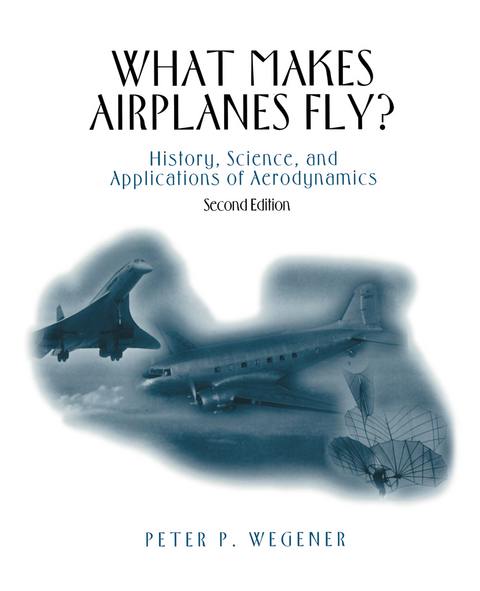
What Makes Airplanes Fly?
Springer-Verlag New York Inc.
978-1-4612-7474-2 (ISBN)
How can an airplane weighing many tons stay aloft for many hours, flying so smoothly that the passengers may feel less like they are moving than they would in a car? The answer, of course, lies in the wings and the air they are moving through, and the study of the flow of air around airplane wings is part of the science of aerodynamics. This book is about aerodynamics in the broadest sense. In addition to airplanes, it discusses the aerodynamics of cars and birds, and the motion of diverse object thorugh air and water. The fundamental notions of mechanics and fluid dynamics -- that is, the basic physics underlying aerodynamics -- are clearly explained. The underlying science is discussed rigorously, but only elementary mathematics is used, and only occasionally. To put the science into its human context, the author describes (with many illustrations) the history of human attempts to fly and discusses the social impact of commercial aviation as well as the outlook for future developments. This book is addressed primarily to readers whose background is not in physics or engineering. It will deepen their knowledge of these fields and add to their appreciation of some exciting recent developements in technology. This new edition has been brought up to date throughout; solutions to selected excercises have been added, as well as new problems and other study aids.
1 A Dream Comes True: The Wright Brothers and Their Predecessors.- 1.1 The First Flights at Kitty Hawk.- 1.2 Mythology and Legend.- 1.3 Early Adventures.- 1.4 From Cayley to the Wright Brothers.- 2 Milestones of the Modern Age.- 2.1 Notes on Aeronautical Research.- 2.2 Great Moments in Aviation.- 3 The Nature of Liquids and Gases.- 3.1 Description and Properties.- 3.2 Behavior of Liquids at Rest.- 4 The Atmosphere of the Earth.- 4.1 History and Composition.- 4.2 Structure.- 4.3 Global Circulation.- 5 Air in Motion.- 5.1 Description of Movement: Kinematics.- 5.2 Conservation of Mass and Energy.- 5.3 Viscosity and Turbulence.- 5.4 The Boundary Layer.- 6 Turning to Aerodynamics.- 6.1 How Do We Test Models of Airplanes?.- 6.2 Drag, Lift, and Other Coefficients.- 7 Aerodynamic Drag.- 7.1 What Is Drag? Blunt Bodies.- 7.2 The Strange Case of the Sphere.- 7.3 Slender Bodies, Skin Friction, Airfoils.- 7.4 Automobiles, Etc.- 8 Aerodynamic Lift.- 8.1 Early Experience and Some History.- 8.2 Lift of the Infinitely Extended Wing.- 8.3 The Finite Wing of an Airplane.- 8.4 How Birds Fly and Why We Cannot Copy Them.- 9 Notes on the Whole Airplane.- 9.1 Stability and Control.- 9.2 Propulsion: From Propellers to Rockets.- 10 Toward High Speed: Supersonic and Hypersonic Flight.- 10.1 Pushing the Speed of Sound.- 10.2 From Supersonic Transports to Future Dreams.- 11 Air Transportation and the Outlook for the Future.- 11.1 The New Traffic Patterns.- 11.2 What Next.- Appendix 1 Facts from Algebra.- Appendix 2 Model Testing and Similarity.- A2.1-Aircraft Nomenclature and Model Testing.- A2.2-Dimensions and Units.- A2.3-Similarity Parameters and Model Testing.- Appendix 3 History of the Metric System: The SI System and Conversion Tables.- Appendix 4 Suggestions for Further Reading.- Appendix 5 Study Guide.- Figure and Table Credits.- Name Index.
| Zusatzinfo | XII, 260 p. |
|---|---|
| Verlagsort | New York, NY |
| Sprache | englisch |
| Maße | 191 x 235 mm |
| Themenwelt | Naturwissenschaften ► Physik / Astronomie ► Mechanik |
| Naturwissenschaften ► Physik / Astronomie ► Strömungsmechanik | |
| Technik ► Fahrzeugbau / Schiffbau | |
| Technik ► Maschinenbau | |
| ISBN-10 | 1-4612-7474-5 / 1461274745 |
| ISBN-13 | 978-1-4612-7474-2 / 9781461274742 |
| Zustand | Neuware |
| Informationen gemäß Produktsicherheitsverordnung (GPSR) | |
| Haben Sie eine Frage zum Produkt? |
aus dem Bereich


